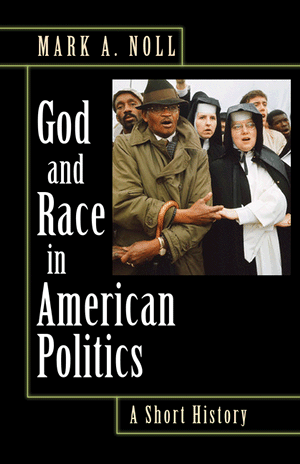
God and Race in American Politics: A Short History
by Mark A. Noll
Shortly before the Revolutionary War, Jupiter Hammon, a poet and a slave from Long Island, became the first African American to publish his writing. The poem, as quoted by Mark Noll, begins: “Salvation comes by Jesus Christ alone, / The only Son of God; / Redemption now to every one, / That loves his holy Word.”
Hammon couldn’t have imagined what “redemption” would come to mean only a century later: not freedom from bondage but rather the collapse of Reconstruction and the federal government’s retreat from enforcing the political rights granted to former slaves.
Now, more than a century since, that “redemption” is often forgotten. Noll’s history – developed from a series of academic lectures, and retaining something of their tone and structure, complete with projector-ready statistical charts – does well to recall it, along with the complex, sometimes unexpected role religion and race played in shaping politics. The book, however academic, does offer something of an antidote to the passions invariably involved in discussions of these subjects, and to slapdash “journalistic punditry.”
The most interesting parts of Noll’s book describe those times when the law of unintended consequences held true. During “redemption,” for instance, as white evangelicals tacitly or even explicitly supported segregation and racial violence, African Americans necessarily built their own churches, which would become the foundation of the Civil Rights Movement of the 1960s. Despite the varied ways of worship, which Noll loosely groups into elite and populist categories, African American churches combined contained “a world of remarkable religious depth and potential social force” that would burst forth in decades to come.
The passage of the Civil Rights Act too had some unforeseen results – especially its empowerment of white evangelicalism. In a table, Noll shows that all the white mainline Protestant churches have lost members in the last 40-odd years, while all the white evangelical Protestant churches have increased membership (importantly, membership in the black Pentecostal church has gone way up as well, and Roman Catholics have netted a whopping 25 million members since 1960).
Why did it happen? Noll explains: “Stripped of racist overtones, southern evangelical religion-the preaching, the piety, the sensibilities, and above all the music-became much easier to export throughout the country,” Noll writes. “Billy Graham had earlier shown how attractive a nonracist form of affective southern evangelicalism could be.” The Civil Rights Movement also brought Christianity back to the front and center of American politics, over the “general theism of anticommunism.” He writes, “It reinvigorated the possibility that some moral principles deserved higher loyalty than the established law of the land.”
That possibility continues to animate much of our contemporary politics, particularly on the topic of gay rights, which Noll briefly discusses. Unfortunately, he wrote too soon to analyze California’s Proposition 8, on which white evangelicals and black Protestants were, perhaps more strongly than on moral questions past, united.
Excerpt: “Christian altruism, Christian philanthropy, Christian consolation, and Christian responsibility are not the only forces for good in American history, but they loom very large and have had very positive effects. And yet…and yet…. The American political system and the American practice of Christianity, which have provided so much good for so many people for so many years, have never been able to overcome race.”
Further Reading: Religion and American Politics: From the Colonial Period to the Present and A Stone of Hope: Prophetic Religion and the Death of Jim Crow




Send A Letter To the Editors